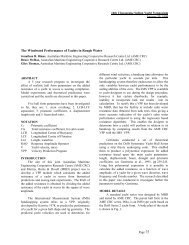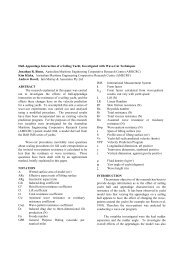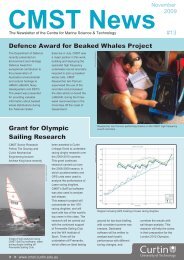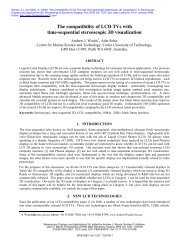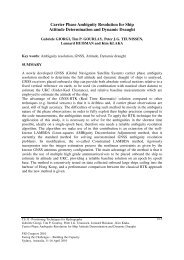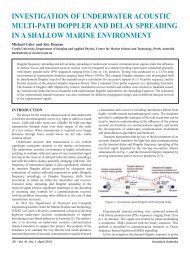Blue whale calling in the Rottnest trench-2000, Western ... - ANP
Blue whale calling in the Rottnest trench-2000, Western ... - ANP
Blue whale calling in the Rottnest trench-2000, Western ... - ANP
You also want an ePaper? Increase the reach of your titles
YUMPU automatically turns print PDFs into web optimized ePapers that Google loves.
1) Introduction<br />
In <strong>the</strong> sou<strong>the</strong>rn hemisphere two subspecies of blue <strong>whale</strong> are recognised, <strong>the</strong> 'true' blue <strong>whale</strong><br />
(Balaenoptera musculus <strong>in</strong>termedia) and <strong>the</strong> 'pygmy' blue <strong>whale</strong> (Balaenoptera musculus<br />
brevicauda). The 'true' blue <strong>whale</strong> is <strong>the</strong> larger of <strong>the</strong> two and may be found south of <strong>the</strong><br />
Antarctic convergence zone, particularly along <strong>the</strong> ice shelf edge feed<strong>in</strong>g on euphausiid krill,<br />
whereas <strong>the</strong> slightly smaller pygmy blue <strong>whale</strong> is preferentially found fur<strong>the</strong>r north (Bannister et<br />
al 1996). The two subspecies are extremely difficult to discern <strong>in</strong> <strong>the</strong> field. Based on Russian<br />
whal<strong>in</strong>g data Zemsky and Sazh<strong>in</strong>ov (1994) presented <strong>the</strong> distribution of pygmy blue <strong>whale</strong>s as<br />
be<strong>in</strong>g primarily <strong>in</strong> <strong>the</strong> Indian Ocean, along <strong>the</strong> African east coast, throughout <strong>the</strong> lower part of<br />
<strong>the</strong> Indian Ocean, along <strong>the</strong> <strong>Western</strong> Australian coast north to Indonesia, and along <strong>the</strong><br />
Australian sou<strong>the</strong>rn coast and east to encompass New Zealand (as displayed <strong>in</strong> Figure 1). The<br />
migratory patterns and movements of <strong>the</strong> blue and pygmy blue <strong>whale</strong> are poorly understood<br />
although each are known to undertake extensive migrations between warm water (low latitude)<br />
breed<strong>in</strong>g areas and cold water (high latitude) feed<strong>in</strong>g areas (Bannister et al 1996).<br />
Figure 1: Pygmy blue <strong>whale</strong> distribution shown as shaded area, from Zemsky and Sazh<strong>in</strong>ov (1994).<br />
These populations were heavily hunted dur<strong>in</strong>g <strong>the</strong> whal<strong>in</strong>g decades of <strong>the</strong> 1950 and 1960's. An<br />
<strong>in</strong>ternational ban on blue whal<strong>in</strong>g was established <strong>in</strong> 1966 due to alarm<strong>in</strong>gly decl<strong>in</strong><strong>in</strong>g numbers,<br />
although it now known that illicit catches of blue <strong>whale</strong>s cont<strong>in</strong>ued up to <strong>the</strong> mid 1970's<br />
(Bannister et al 1996). The 'true' blue <strong>whale</strong>s were almost driven to ext<strong>in</strong>ction dur<strong>in</strong>g this period.<br />
From an estimated pre-whal<strong>in</strong>g population of sou<strong>the</strong>rn hemisphere 'true' blue <strong>whale</strong>s of around<br />
160,000-240,000 animals, whal<strong>in</strong>g reduced numbers to < 1000 animals, which is still 34 years<br />
after <strong>the</strong> official cessation of whal<strong>in</strong>g, near <strong>the</strong> estimated current population size of 1000-<strong>2000</strong><br />
animals (Bannister and Burton <strong>2000</strong>). Pygmy blue <strong>whale</strong> stocks were less heavily exploited and<br />
dropped from an estimated total population size of 12,500-13,000 animals pre-whal<strong>in</strong>g (Zemsky<br />
and Sazh<strong>in</strong>ov 1994), with an estimate of <strong>the</strong> current population at 6000 animals (Bannister et al<br />
1996).<br />
4




